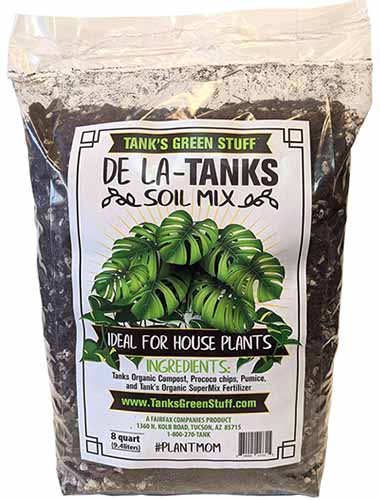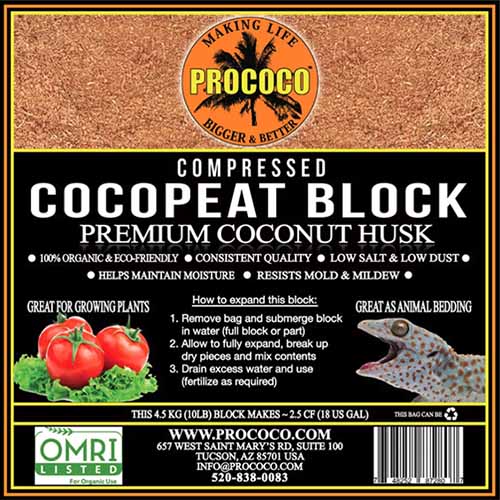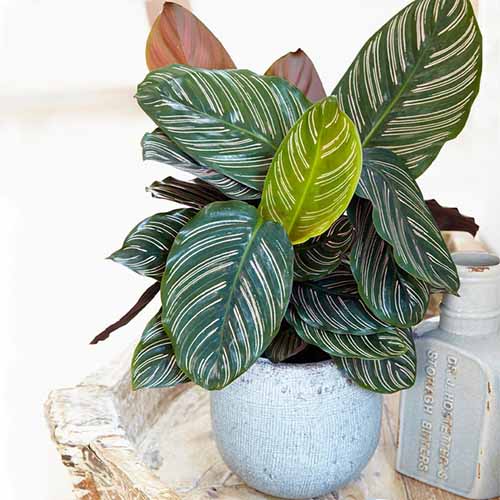How to Grow and Care for Pinstripe Plant
Goeppertia ornata (aka Calathea ornata)
While some prayer plants are known for their almost outlandishly patterned leaves, the pinstripe plant has a quieter beauty that’s subdued and elegant.
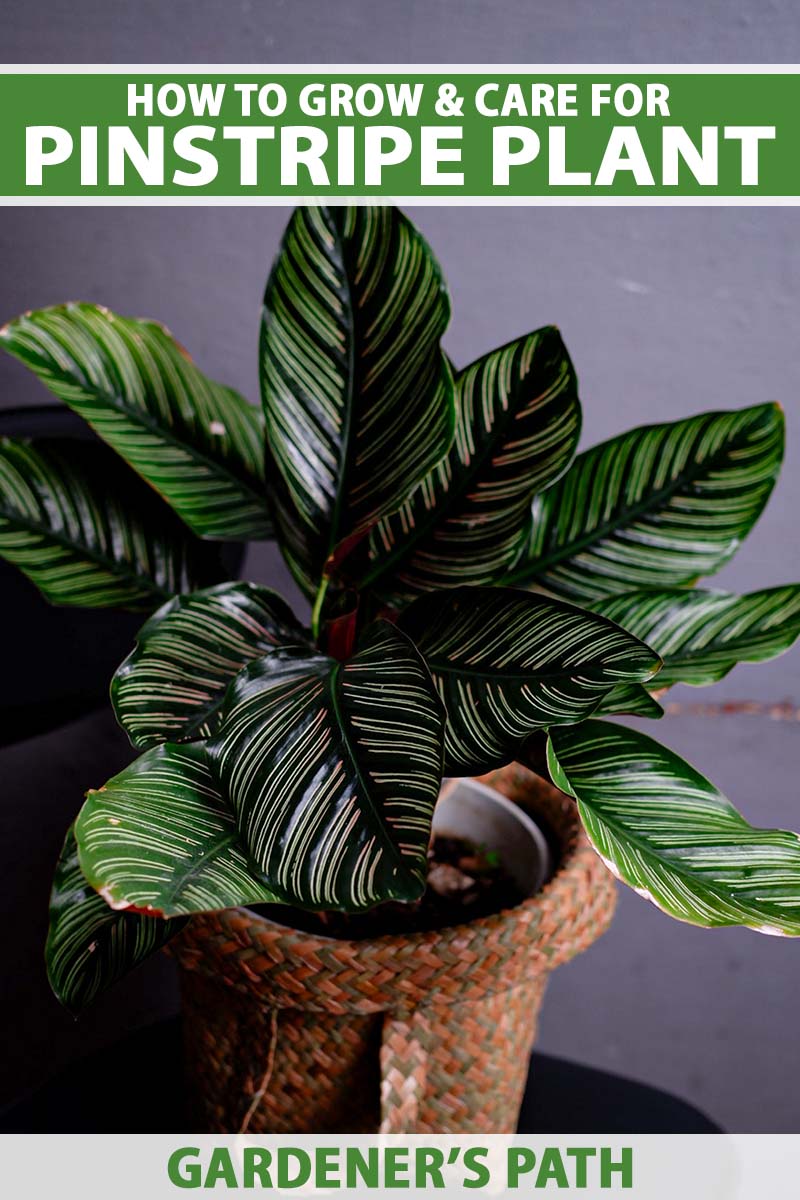

We link to vendors to help you find relevant products. If you buy from one of our links, we may earn a commission.
This calathea makes an excellent foliage houseplant that will blend with many different styles of decor.
It’s also easy to take care of once you have a good understanding of its needs – and that’s exactly what we’re going to cover in this article!
Here’s what we’ll go over:
What You’ll Learn
For the purposes of this article we’re going to be talking about the houseplant known in scientific circles as Goeppertia ornata, formerly known as Calathea ornata.
There are other prayer plants that are sometimes called “pinstripe plant” as well, and we’ll discuss those too. Shortly, I’ll explain how to differentiate these different species.
But before we get started, if you’re looking for general care guidance for all sorts of prayer plants, be sure to read our complete guide.
What Is Pinstripe Plant?
G. ornata is an evergreen, herbaceous perennial that has smooth, oblong, and slightly asymmetrical leaves with smooth margins. The leaves are dark green and patterned with delicate, wispy stripes ranging from cream to pink.
One of the cultivars of this species, ‘Beauty Star,’ has the additional feature of a pale green background between the midrib and the margins of the leaves, which makes its stripes stand out more prominently. The underside of each leaf is deep purple.
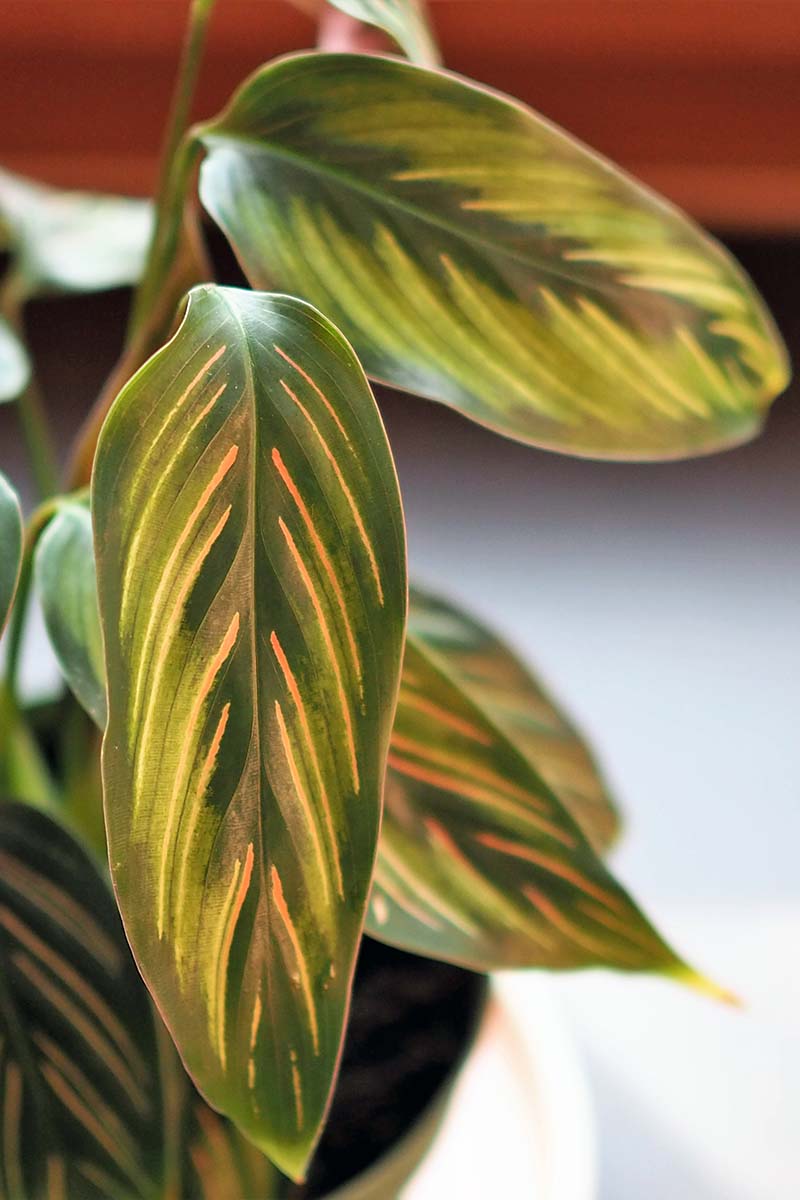

G. ornata grows to be two to three feet tall by two to three feet wide and has a fountain-like growth habit, with stems supporting just one leaf each. It grows from rhizomes, forming new clumps as it matures.
Spikes of small white or pink flowers may appear in summer, though this is rare with houseplants.
The pinstripe plant is a type of prayer plant and it exhibits the same “praying” movements with its leaves as its relatives, lifting them at night, and lowering them again after sunrise.
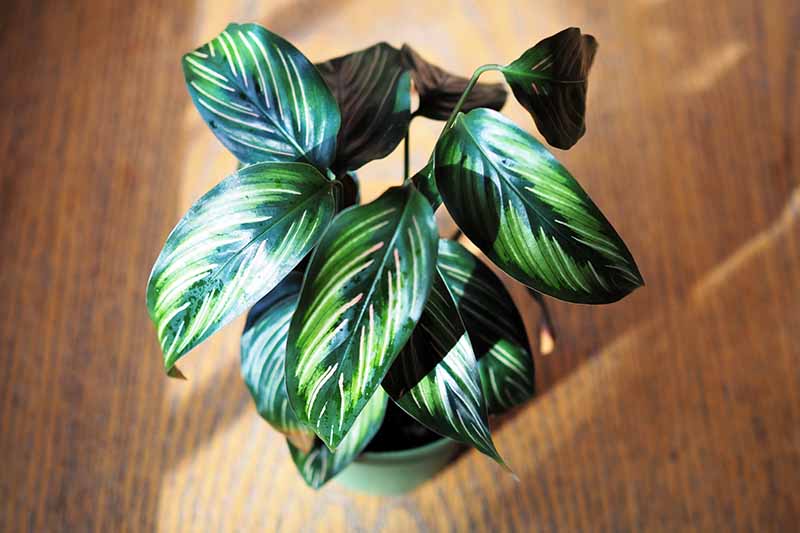

The common names “pinstripe plant” or “pinstripe calathea” are also sometimes used for other Goeppertia species, such as G. elliptica, which bears white stripes on its leaves. Compared to this species, G. ornata has much more delicately patterned leaves.
The subject of our article is also sometimes confused with G. majestica ‘White Star,’ which has more densely striped leaves, making its leaves mostly white and pink rather than being mostly green.
Finally, it’s sometimes also confused with G. sanderiana, whose leaves are broader than those of G. ornata.
You may be starting to get the idea that our pinstripe calathea has endured a bit of an identity crisis – and if that’s what you were thinking, you’re quite right!
In fact, according to botanist Dr. Helen Kennedy, this identity crisis encompasses more than just a broadly applied common name.
According to Kennedy, this identity crisis is due to the fact that the juvenile forms of several calathea species look very much like each other, and when labeling plants, many horticulturalists based their assumptions about these plants’ identities on their juvenile forms and not their mature ones.
In fact, Kennedy says that because of this horticultural mixup, the specimens commonly sold as G. ornata these days may not be G. ornata at all, but instead may be another species altogether, a certain G. regalis.
By the way, if you are a calathea buff, you may recognize Kennedy’s name – the ‘Helen Kennedy’ calathea was named in her honor.
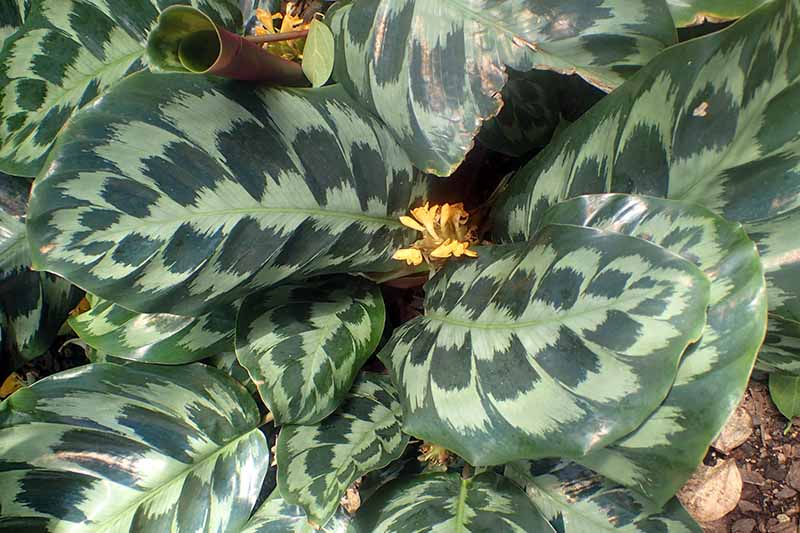

Whatever the true identity of the houseplants sold as G. ornata, since these other species commonly referred to as “pinstripe calatheas” have very similar needs as the main subject of our article, our approach to care remains the same.
You’ll learn a little more about these other species and cultivars and get tips on where to find specimens of your own later in this article.
Cultivation and History
A native of southeastern Colombia and southwestern Venezuela, in the wild G. ornata grows as an understory species in tropical forests.
This member of the Marantaceae family is closely related to other well-loved prayer plants such as network calathea, peacock calathea, and red-veined maranta.
You can learn more about these species and others in our roundup of 21 of the most stunning species of prayer plants to grow at home.
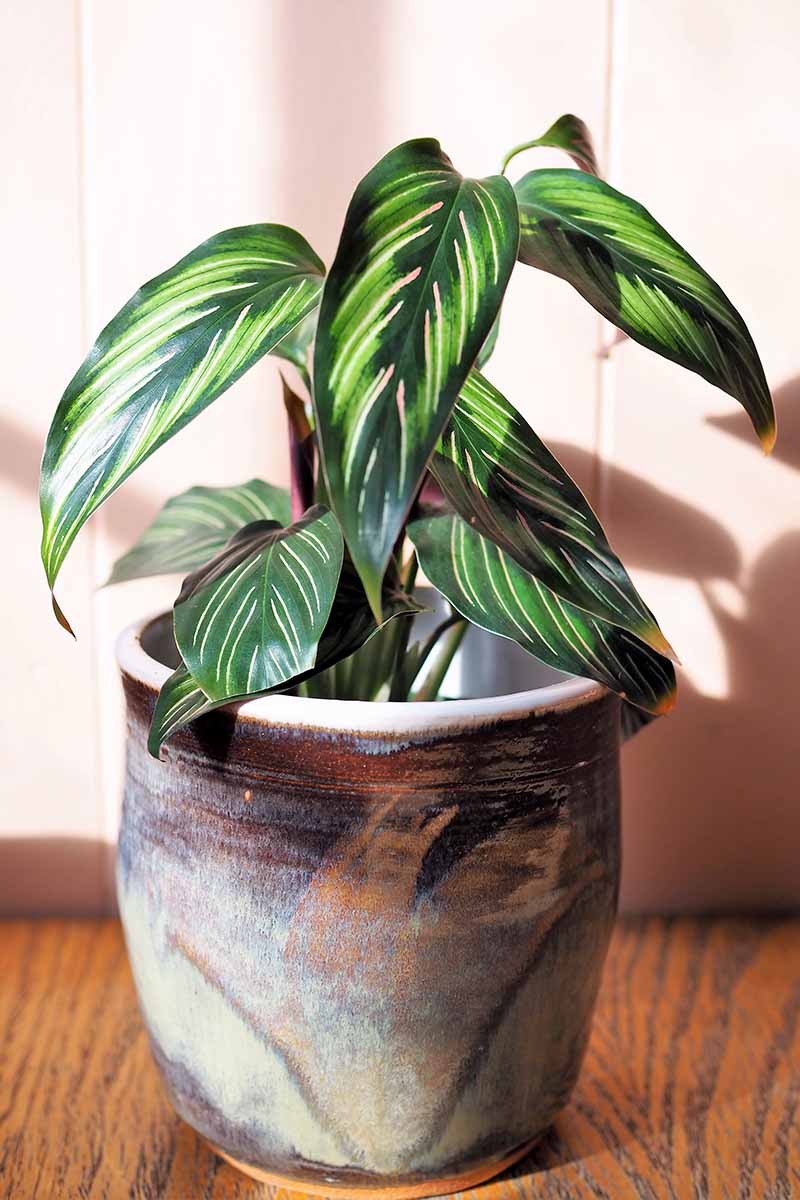

This species is referred to as Calathea ornata more often than it is by its official botanical name G. ornata.
The bulk of the calatheas were reclassified in 2012, and popular culture hasn’t quite caught up with science yet, so you’ll most likely find this houseplant referred to as a calathea – and that’s how I will refer to it in this article as well!
This species is also sometimes called Maranta ornata, Phyllodes ornata, Phrynium ornatum, and Maranta coriifolium, all of which are previous taxonomic classifications.
The genus Goeppertia was named to honor Heinrich Goeppert, a German botanist, and the specific epithet ornata means “adorned.”
This calathea is quite tender and can only be grown outdoors year-round in USDA Hardiness Zones 12 and up.
Propagation
Calathea seeds are hard to come by and tricky to propagate, so your best option for propagating pinstripe calathea is via division.
It’s best to carry out this task in the spring when your specimen is putting on new growth.
To determine whether you can divide your specimen, first inspect the stems where they emerge from the potting soil.
Do you see various different clumps? If so, that means you have rhizomes that can be divided.
For best results with propagation, make sure each clump has at least three leaves.
To divide your houseplant, get your potting supplies ready, then remove the plant from its pot and gently work the different clumps apart from each other.
Follow the potting instructions as indicated in the repotting section below.
How to Grow
It’s not terribly difficult to keep pinstripe calatheas happy, as long as you provide them with what they’ll need to meet their basic requirements.
Here’s what you need to know:
Choosing a Plant
If you want to avoid the frustrations of pests, disease, and failing floral companions, be sure to start with a healthy specimen.
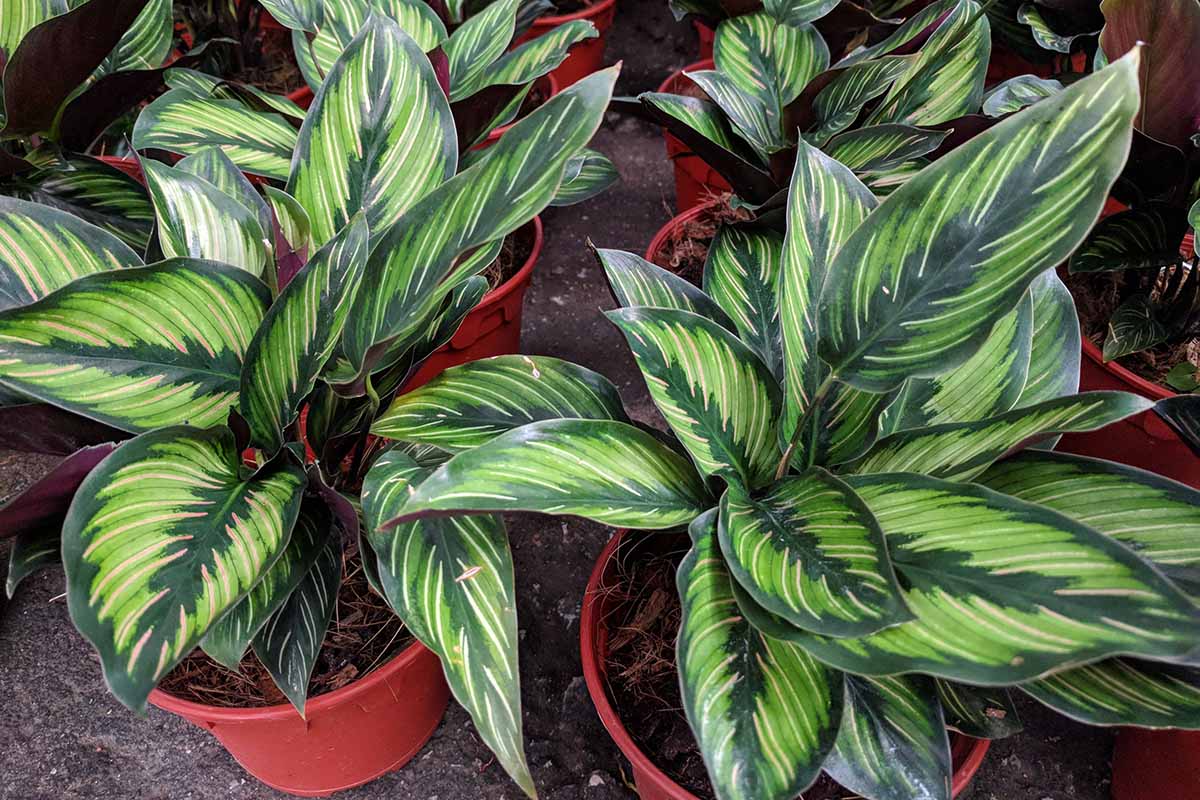

Avoid specimens that have browning or yellowing leaves and look for signs of pests. You’ll learn more about inspecting this calathea for pests and diseases later in this article, so keep reading!
Light
Pinstripe calathea will thrive best in medium, indirect light.
It can also adapt to low, indirect light but be careful of direct sun which will cause this plant a great deal of stress.
A little direct sun in the morning is well tolerated, but avoid hot midday or afternoon sun exposure.
Temperature
As a species originating in the tropics, pinstripe calathea will be happiest at temperatures ranging between 65 and 85°F.
When positioning your houseplant in your home, try to avoid locations that are prone to temperature fluctuations, such as those near cold, drafty windows or central heating vents blowing hot, dry air.
Soil
Members of the Marantaceae family require a rich, peaty growing medium to stay hydrated. However, they also require excellent drainage.
G. ornata tolerates soils that are slightly acidic to slightly alkaline, with a pH ranging from 6.1 to 7.8.
And since prayer plants are prone to brown tips, it’s best to avoid growing mediums that include perlite, since the fluoride content in this common ingredient can cause tip burn.
My preferred peat-free potting mix for these plants is actually a combo – I like to mix one part coconut coir to help retain moisture with one part De La Tank’s Houseplant Soil Mix, which provides good drainage as well as ingredients that will promote healthy growth, such as compost, biochar, and humic acid.
You’ll find De La Tank’s Soil Mix in one-, eight-, or 16-quart bags from Tank’s Green Stuff via Arbico Organics.
If you don’t already have a supply of coconut coir (also known as cocopeat) on hand for gardening use, you can purchase it in a compressed block, which makes it more space efficient.
10-lb Prococo Compressed Coconut Coir Block
You can find a 10-pound block of compressed coconut coir for purchase from Prococo, also available via Arbico Organics.
Water
G. ornata prefers moist soil, so don’t let it dry out much between waterings. I like to water my prayer plants when the surface of the soil has just barely started to dry.
For me, this means I water these plants once a week, more or less, but slightly less frequently during the winter, and slightly more frequently during the summer.
However, the conditions in your home may be different than mine, so adjust this schedule according to your own conditions.
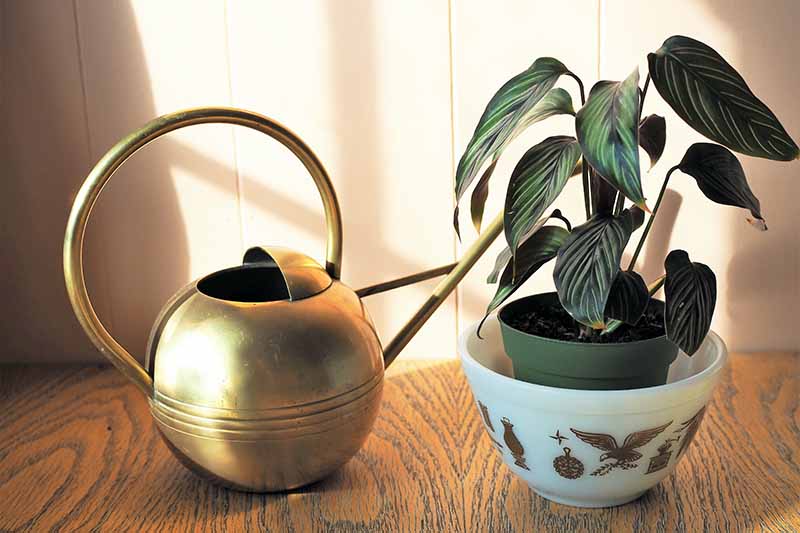

Remove your calathea from its decorative pot or lift it from the saucer and place it in a bowl, sink, or bathtub when watering.
Use a houseplant watering can to evenly hydrate the surface of the soil, watering until liquid runs out of the drainage holes in the bottom of the pot.
Wait until the water has finished draining before returning it to its decorative pot or placing it back on top of the drainage saucer.
You might also want to try the bottom watering method for this plant.
Humidity
Prayer plants require higher than average humidity, and pinstripe calathea is no different.
Aim for humidity that is between 40 and 60 percent. If you live in a climate with humid summers, you should be all set and won’t need to add any more moisture to your air.
However, during wintertime, and for those of us in more arid climates, a few extra measures can help.
I grow humidity-loving houseplants such as pinstripe calathea in my arid climate by keeping them grouped with buddies, and placed in terrariums.
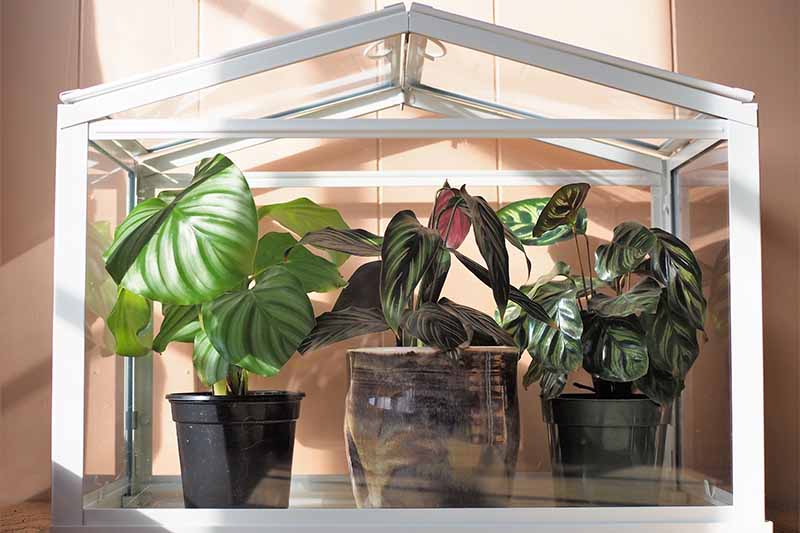

The houseplant buddies help to raise the ambient humidity, and the terrarium helps to hold the moisture in. (It also helps to protect my plants from my curious cats.)
Another method of raising relative humidity is to place your houseplants on humidity trays, such as this black plant stand and humidity tray from the Humidi-Grow Store, available for purchase via Amazon.
13.5” x 10.5“ Plant Stand and Humidity Tray
Finally, another option that can help is using a humidifier near your pinstripe calathea.
Growing Tips
- Provide medium, indirect light.
- Keep soil moist but not wet, and offer extra humidity if needed.
- Avoid drafts and temperature extremes.
Pruning and Maintenance
As long as you follow the care tips mentioned above, your houseplant won’t require much maintenance. However, here are a few other tips that might be helpful for keeping your calathea in great shape:
Pruning
You’ll only need to prune your pinstripe calathea if you want to shape it up a bit or if it gets the occasional brown leaf tip.
Like other prayer plants, G. ornata is quite sensitive to temperature and humidity fluctuations and it’s not uncommon to find brown leaf tips, even on well-cared for specimens.
If you notice brown tips, feel free to prune them off with a pair of sterilized scissors. You can wipe the scissors down with rubbing alcohol or hydrogen peroxide to sterilize them.


If you get quite neglectful and miss a watering or two, you might notice more than just a brown leaf – instead, you might find entire leaves that have gone crispy.
To keep your specimen looking good, you can trim back the dead leaf as close as possible to the soil surface.
There are many causes for brown leaves on prayer plants – learn how to troubleshoot this issue in our guide.
Fertilizing
Prayer plants prefer a gentle fertilizing regimen, so I like to use worm compost tea to nourish them.
If you don’t have worm compost bins of your own (yet!), you can fertilize your houseplant using worm compost tea sachets.
To use this method, you soak these “tea” bags in room temperature water and feed your plants while watering.
Teadrops All Purpose Houseplant Fertilizer
You can purchase organic worm compost tea sachets from Earthworm Technologies via Amazon.
Cleaning Leaves
When it’s time to water your houseplant, this is a good opportunity to give its leaves a quick cleaning.
Rather than using any chemically formulated products for this, I recommend doing the job with a damp paper towel.
Wipe each leaf down, top and bottom, and make sure the leaves remain relatively dry.
Repotting
As a fairly slow grower, pinstripe calathea will only need to be repotted every two or three years.
Your houseplant will send you signs that it’s time to repot.
If it dries out so quickly that you have to water two or three times a week, you can take that as a sign.
Additionally, if roots are emerging from the surface of your plant’s soil or the drainage holes in its pot, it’ll need repotting.
Also keep in mind that the best time to repot is in the spring when the plant is actively growing.
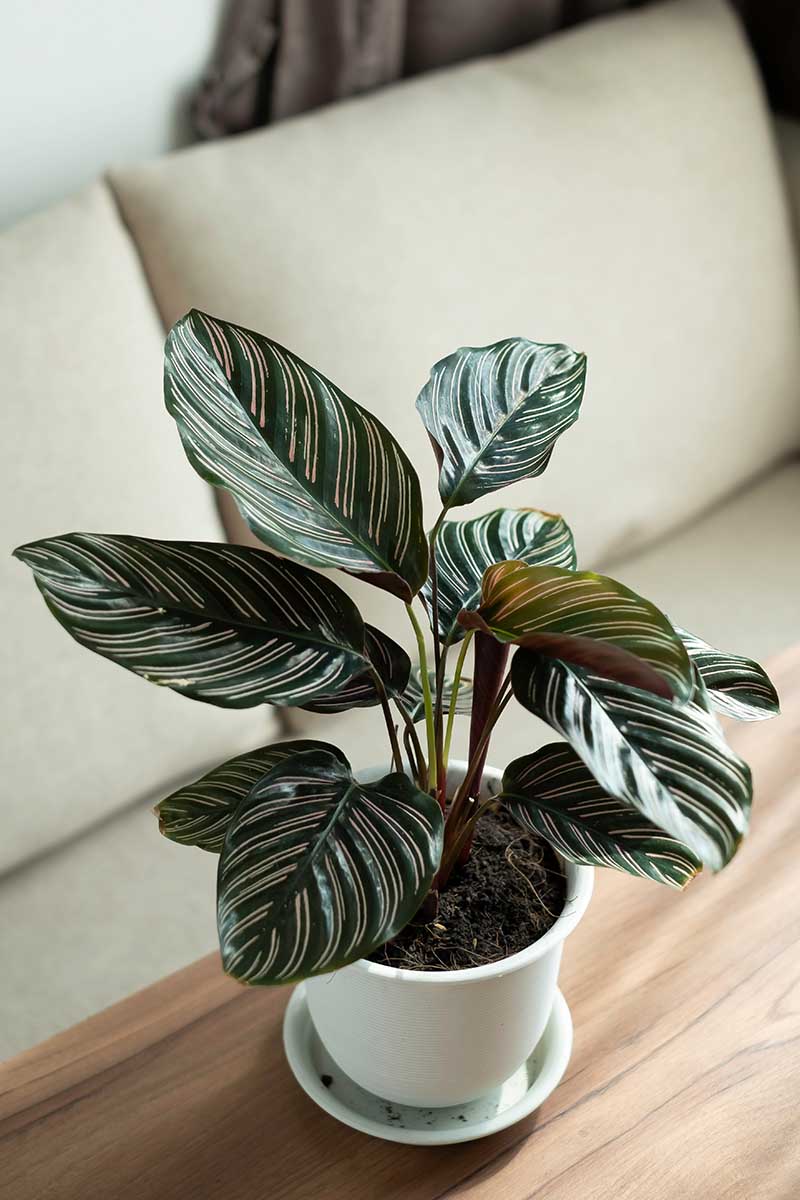

When you choose a new pot, make sure it’s just one size larger that your houseplant’s current one – and make sure it has drainage holes in the bottom.
When you’re ready, grab the new container and your growing medium, and remove the calathea from its current pot.
Next, loosen its outer roots by rubbing your hand along the edge of the root ball. This will help to ease the transition to its new potting medium.
Put a little soil in the bottom of the new pot, center your plant, and adjust it so the top of the soil is about half an inch from the rim of the pot.
Fill the pot in with potting medium, being careful not to cover your calathea’s crown with soil, and then water your newly potted plant.
Species and Cultivars to Select
Here is some additional info on the calatheas commonly referred to as “pinstripe plants” as well as tips on where you can purchase your own.
Beauty Star
‘Beauty Star’ is a cultivated variety of G. ornata. Its dark green leaves have flushes of pale green between the midrib and leaf margins, forming a light green background behind delicate creamy pink stripes.
The stripes appear in a wispy, feathery pattern and the undersides of the leaves are deep purple.
This cultivar tends to grow only up to eighteen inches tall and wide, and its flowers are pink.
Live ‘Beauty Star’ Plant in 6” Pot
You can purchase a live ‘Beauty Star’ specimen in a six-inch pot from the American Plant Exchange via Amazon.
Elliptica
G. elliptica (also known as Calathea vittata) is a distinct species that has medium-green leaves with white stripes and pale green leaf undersides.
Its stripes are less wispy than those of G. ornata, covering more surface area of the leaf.
This calathea is sometimes called “peacock plant” (a common name usually reserved for G. makoyana) but is just as often called “pinstripe plant.” (You’re probably starting to understand why scientific names are useful!)
Hardy in USDA Zones 10b to 12, this species grows to be eight to 12 inches tall with a six- to eight-inch spread.
Live G. Elliptica Plant in 4” Pot
You’ll find a live starter specimen of G. elliptica in a four-inch pot from the Hirt’s Gardens Store via Amazon.
Ornata
G. ornata is the original pinstripe calathea and the main star of this article.
… Or is it actually G. regalis, as researcher Dr. Helen Kennedy suggested?
We may never know. Let’s just call it pinstripe plant and enjoy it!
Live Pinstripe Plant in 6” Pot
You can purchase a pinstripe plant in a six-inch pot from Fast Growing Trees.
White Star
If you find a specimen of G. majestica for sale, it will mostly likely be the ‘White Star’ cultivar.
This cultivated variety has dense bands of pink to white stripes on its leaves.
Live G. Majestica ‘White Star’ Plant in 4” Pot
Unlike G. ornata, which is slightly more cold hardy, this species can only live outdoors year-round in USDA Hardiness Zone 13.
You can purchase a live ‘White Star’ in a six-inch pot from Wekiva Foliage via Amazon.
Managing Pests and Disease
G. ornata and its prayer plant relatives tend to be spared problems with pests and diseases, so it’s not very likely you will have to deal with these issues.
However, it’s always good to know what to look for, particularly when adding a new specimen to your household.
Insects
Insects and other pests might set up camp on your houseplant while summering outdoors, or they might hitchhike in on a newly acquired specimen.
Here are some of the most common pests to target these houseplants:
Mealybugs
If I had to pick a favorite houseplant pest, it would be the mealybug. It’s strange to pick favorites, I know (why can’t I love them all equally?), but these little white insects are rather fascinating.
From a distance, they look like tiny bits of white fluff – but up close they look like the type of ancient underwater creatures that you might find exploring deep ocean floors.
Fascinating or not, these little bugs are not friendly, at least not to our houseplants. They can be found hunkered down on stems and the undersides of leaves, feeding away on your plant, leaving it undernourished and weak.
And if that wasn’t trouble enough, as they feed, they leave behind sticky honeydew, which can allow fungal pathogens to thrive.
Though mealybugs are my favorites, I don’t let them hang around on my houseplants, and I recommend you take the same strategy. You can learn more about controlling a mealybug infestation in our complete guide to dealing with this pest.
Scale
While mealybugs disguise themselves as fluff, scale insects seem to disguise themselves as bumps. They can be hard to detect on houseplants, blending in easily with stems and feeding on leaves out of sight, on their undersides.
Like mealybugs, when scale insects infest our houseplants, they are using them as food, sucking nutrients and weakening the plants.
There are many different types of scale. To learn more about identifying them and controlling infestations, read our complete guide to fighting scale insect pests.
Spider Mites
While spider mites aren’t insects, they are common houseplant pests that every plant parent should be aware of.
Relatives of mites and ticks, these tiny arachnids can cause stippled leaves on houseplants, and, if the infestation is bad enough, they will also drape foliage in webbing.
To learn more about these pests, be sure to read our article on detecting and controlling spider mite infestations.
Disease
Disease is not often an issue with calatheas, but it’s good to know what to be on the lookout for. Here are some of the diseases you are most likely to encounter in these houseplants:
Cucumber Mosaic Virus
Do you see strange yellow patterns on your calathea that look somewhat like a mosaic? If so, cucumber mosaic virus may be the cause.
This viral disease can infect your calathea, causing cosmetic damage that won’t actually harm the specimen beyond blemishing its good looks.
Prevention is important since there’s no treatment for cucumber mosaic virus, so be sure to wash your hands and sanitize all tools before handling your calathea.
Although this disease won’t threaten the life of your houseplant, disposing of infected specimens is the only way to ensure the disease doesn’t spread to other houseplants.
Helminthosporium Leaf Spot
Have you noticed brown or tan lesions with yellow halos on your calathea? If so, Helminthosporium leaf spot may be to blame.
This disease is caused by various fungal organisms and causes lesions on leaves which grow larger over time.
Prevention is the best approach, so avoid placing your houseplant in damp, cool conditions, which will allow these fungi to thrive.
If it’s too late and you discover an existing infection, you can fight this disease with neem oil, a natural and nontoxic fungicide.
I recommend TheraNeem brand neem oil, available for purchase from Organix South via Amazon.
Neem oil is usually diluted before applying, so be sure to follow the manufacturer’s instructions when using this product.
Root Rot
Does your houseplant have yellow leaves and look thirsty and sad despite having moist soil? If so, root rot may be the problem.
This disease, often caused by soilborne fungi, can affect houseplants when their potting soil remains too wet for too long.
To prevent root rot, make sure the plant’s pot is not overly large, has adequate drainage holes, and that the soil is well-draining. And when watering, be sure to hydrate your plant so the soil is moist but not soggy, and never leave it to sit in standing water.
If your pinstripe plant is suffering from root rot, make sure to identify the cause of the problem so you can remedy it.
Next, take the plant out of its pot and check its roots – healthy roots should be firm and white or cream-colored. Rotten roots will be dark and mushy.
Using a sterilized pair of garden pruners, trim off any roots that look unhealthy, and if needed, repot into fresh, well-draining soil and a smaller pot.
While root rot is one cause of yellow leaves in G. ornata, there are other causes too. Read our article on troubleshooting yellow leaves on prayer plants to learn more.
Best Uses
Pinstripe calathea makes a beautifully subdued foliage plant that can complement other houseplants with brighter foliage such as arrowhead vine, Chinese evergreen, or nerve plant when used in a grouping.
It can also be used for interiorscaping, creating indoor landscapes in public spaces such as office buildings.
Calatheas are nontoxic, making them excellent plants for homes with children and pets.
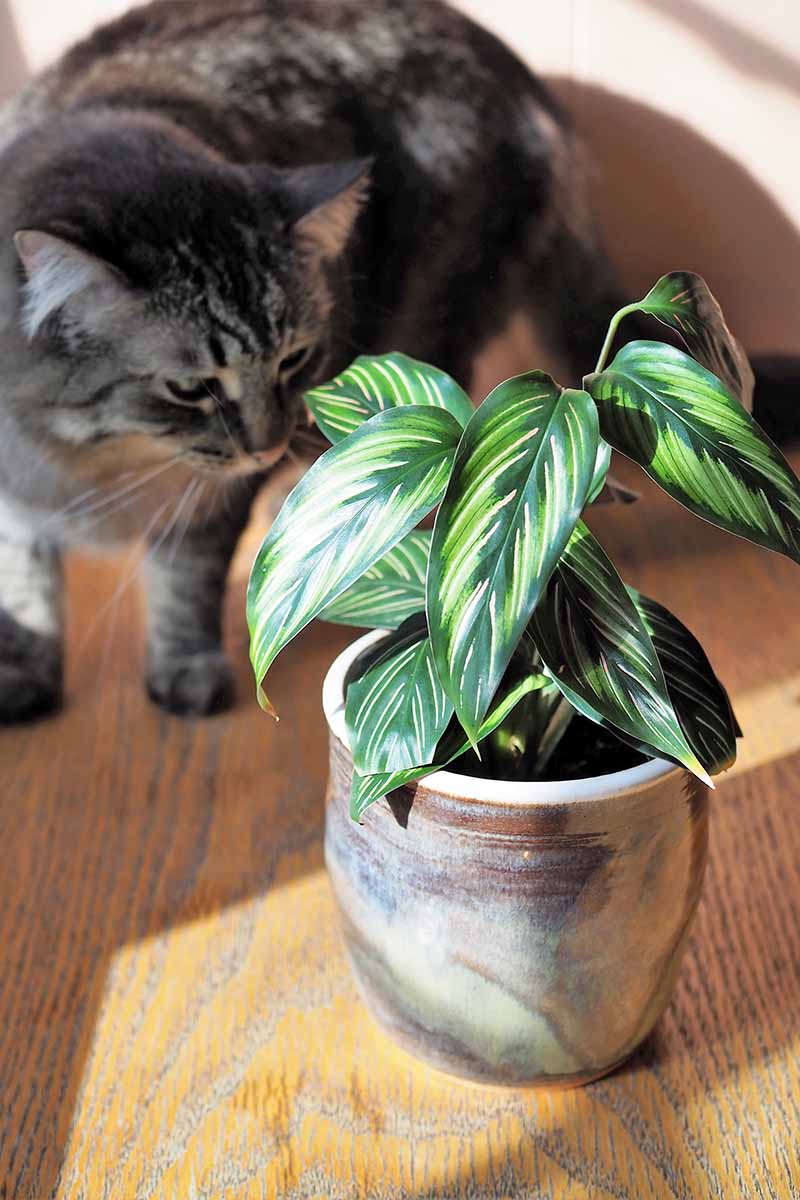

In addition to providing a safe houseplant option, G. ornata may also help to improve air quality, such as through the reduction of formaldehyde, a common indoor air pollutant. Note that these studies typically reference a small, controlled space, not an entire room or house.
While most often used as a houseplant, this member of the Marantaceae family can grow outdoors in USDA Hardiness Zones 12 and higher.
Quick Reference Growing Guide
| Plant Type: | Evergreen herbaceous perennial | Flower/Foliage Color: | White or pink/green with cream to pink stripes, purple undersides |
| Native to: | Colombia and Venezuela | Soil Type: | Peaty, rich |
| Hardiness (USDA Zone): | 12-13 | Soil pH: | 6.1-7.8 |
| Bloom Time: | Summer (rare indoors) | Soil Drainage: | Well draining |
| Exposure: | Medium indirect light | Companion Planting: | Begonia, monstera, orchid, philodendron, pilea, snake plant, spider plant |
| Height: | 2-3 feet | Uses: | Ornamental houseplant; outdoor foliage plant in Zones 12 and up |
| Spread: | 2-3 feet | Order: | Zingiberales |
| Water Needs: | Medium | Family: | Marantaceae |
| Maintenance: | Moderate | Genus: | Goeppertia (syn. Calathea) |
| Tolerance: | Humidity, low light | Species: | Ornata |
| Common Pests: | Aphids, fungus gnats, mealybugs, root knot nematodes, scale, spider mites | Common Diseases: | Cucumber mosaic virus, Helminthosporium leaf spot, Pyricularia leaf spot, root rot |
A Delicate and Ornate Beauty
Now that you know all about the pinstripe plant’s needs, you should be ready to keep your houseplant healthy and happy.
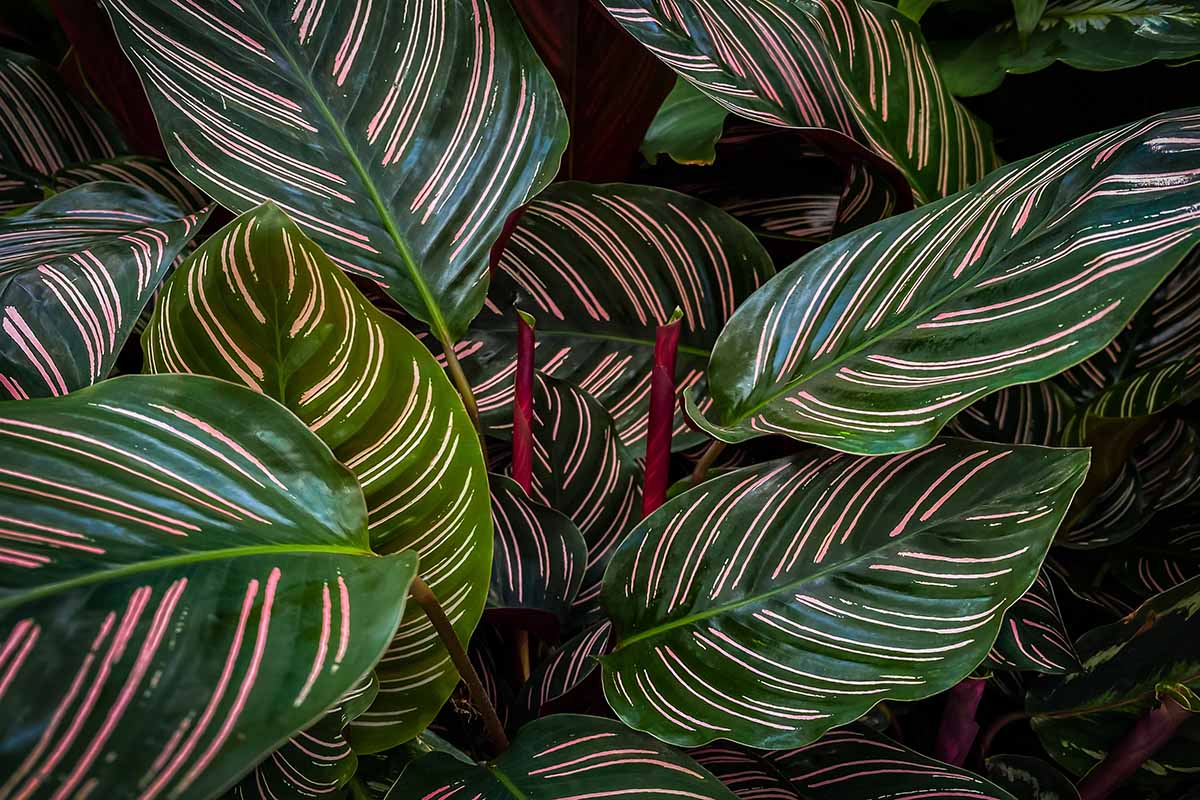

But if you run into any problems, let us know in the comments section below and we’ll do what we can to help! And by the way, which pinstripe plant do you have? G. ornata, ‘Beauty Star,’ or something else entirely? Feel free to share your pics in the comments section too.
If you’re ready to learn about some other fabulous prayer plants, you can keep reading right here:

